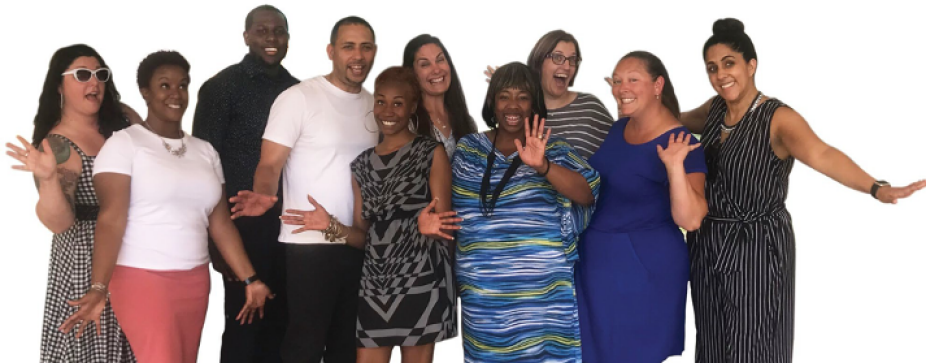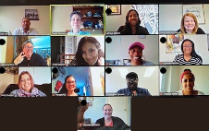
Shaping leaders outside academia with unique, hands-on, in-school residency experience and pandemic-era lessons
BY MELINDA MILLER
The 10 principals-in-training in the inaugural class of GSE’s new Buffalo Aspiring Leadership Academy, or BALA, worked in local public schools, got the unique immersive experience they signed up for and an unexpected pandemic lesson in leadership: As they assisted their principal mentors, helped teachers with online lessons and found ways to get school meals to students stuck home, they got a first-hand experience in crisis management.
“Leaders face ambiguous, complex, nebulous situations every single day. They got thrust into leadership,” said Teresa Lawrence (EdM ’93, PhD ’09), the BALA liaison for UB, the Buffalo Public Schools and the residents. “They were actively a part of transitioning online … You couldn’t teach that by a case study. It was nothing shy of an authentic learning experience and it really called upon them to lead.”
BALA, a new collaboration with GSE and BPS, was created for educators employed in the school system. The 15-month program includes coursework and a yearlong placement at a school with a principal mentor.
To give schools a chance to adjust new challenges this fall, Lawrence has been shepherding the program’s second year through a hiatus. The upcoming class of 2021 will wait until January to start, she said.
For the first BALA students, finishing the program’s inaugural year during the spring pandemic confirmed their school leadership ambitions. When COVID-19 closed schools, they collaborated from home with their mentors and teachers via teleconferencing, messaging, phone calls and personal check-ins with at-risk students.
The pandemic’s school closures led Natasha Mehta to realize that she thrived on the pressure of the leadership work she did at her assigned residency at D’Youville Porter Campus School. “It hasn’t turned me off on the job,” said Mehta, a former school social worker. “In fact, I miss it!”
How it works
BALA was designed to find out if extended residency was better preparation than traditional classroom-based certification. The Wallace Foundation, a philanthropic educational organization, helped develop the idea in New York City after school superintendents reported poor preparation as a key problem with new principals.
“BALA is the full experience. It is not only being in the schools, it is being responsible for planning and organizing and participating—even on Saturday mornings sometimes—so they have a clear understanding of the work,” Lawrence said. “They are fully exposed to the job’s requirements, its demands, all the good and the bad.”
The program was funded by a $1.3 million state education grant with supporting staff help from UB and the Buffalo schools. Classes emphasize cultural responsiveness to a diverse student body and include curriculum leadership, English as a new language and urban school demographics.
“Equity is at the center of it all—making sure that every student has the same chance
at a good education.”
"Even high-performing districts have issues of equity that need to be addressed,” said Corrie Stone-Johnson, faculty liaison and associate professor for educational leadership and policy. Nearly every district has issues of equity that need to be addressed, she said.
She was pleased that the program setup attracted a more diverse group than traditional GSE applicants for the School Building Leadership certification training. Members of the first BALA class had school experience ranging from less than 10 years to two decades.
“These are 10 people who have worked and clawed their way to succeed in their profession,” Lawrence said. “Many are Buffalo schools’ graduates, and they have a passion for urban school education. They are incredible people who believe they can change the world.”
Ambition in action
The COVID-19 disruption led Mehta to an observation about student differences that she is now curious to address in her career ahead. While there were students at D’Youville Porter Campus School who needed more help to stay on track, the ones who thrived surprised her: Some who weren’t really engaged in the classroom did really well with distance learning.
“They are submitting more assignments, asking questions, and participating more,” said Mehta. “We’re all concerned about children who are in less than ideal settings, not only for learning now but for their long-term prospects. This lack of interaction can widen the digital and the social divides.”
Another point clarified during the pandemic: Principals must consider home life, parents and families as they lead teachers and students.
Insights about the importance of reaching out to families were part of Erich Wheeler’s early leadership insights during his residency at Riverside Academy. They came out of an assignment that didn’t seem at all related to a principal’s job duties: Moving furniture.
“I actually had a dolly in my office,” said Wheeler, a former high school computer science teacher. “It was kind of a joke.”
The principal gave him the task, he later realized, as a kind of test. “He was waiting for me to start taking the initiative,” Wheeler said. On his own, he decided to set up a dedicated space—using some of that furniture—for parent meetings.
That’s when he learned how outreach to families can really help students. Working with parents to foster one-on-one teacher communication, offer technology assistance and taking time to understand personal difficulties encourages parents to engage more with their children’s school.
“I have progressed from being a glorified janitor,” said Wheeler, “to leading student support and handling suspensions.”
Working as a principal made Holly Hudson realize how interconnected a school community is. Making it work means strengthening all the bonds and building an education “family.”
“At the building that I am in, the principal leads with ‘family first.’ These kids need to feel loved before they can learn,” said Hudson, a former music teacher placed at Frank A. Sedita Academy.
“You can’t understand why kids are acting out if you don’t understand that they are hungry, that they are tired. You need to know who you are teaching,” she said. “It has been the best blessing—to be doing this, in this year, as crazy as it is.”

- Ashley Elliott, a new assistant principal at Dr. Lydia T Wright School. Residency:
Highgate Heights Elementary School.
- Holly Hudson, a new job as music teacher at West Hertel Academy. Residency: Frank A.
Sedita Academy School.
- Natasha Mehta, a new assistant principal at Dr. Charles R. Drew Science Magnet School.
Residency: D’Youville Porter Campus School.
- Mary Pope, a new coordinating supervisor of grants in the Multilingual Department at
Buffalo Public Schools. Residency: Herman Badillo Bilingual Academy.
- Jillian Santoro, an elementary school teacher at the Roosevelt Early Childhood
Center. Residency: Lafayette International High School.
- Christopher Spence, a new assistant principal for the middle school at Math Science Technology Preparatory School. Residency: the New BUILD Community School.
- Chanelle Wallace, a third grade teacher at Community School. Residency: Hamlin Park Academy.
- Maureen Williams, a new assistant principal at Marva J. Daniel Futures Preparatory School, where she did her residency.
- LaFraya Wilson, is a new assistant principal at West Hertel Academy, where she did her residency.
- Erich Wheeler, a new assistant principal at International Preparatory School. Residency: Riverside Academy.